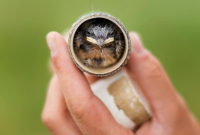Support strong Canadian climate journalism for 2025
This story was originally published by The Guardian and appears here as part of the Climate Desk collaboration
Hummingbirds might be instantly recognizable from their eponymous sound, but the cause of the characteristic has long been a mystery.
Now researchers say they have cracked the conundrum, finally taking the “hmm?” out of hummingbirds.
David Lentink, the assistant professor of mechanical engineering at Stanford University and a co-author of the research, says that while the hum was known to be linked to the movement of the wings, it was previously unclear what exactly was behind the sound. Pressure changes generated by the flapping, vortices in the air flow, and whistling sounds from the feathers themselves were all among the possibilities.
Now it seems the answer predominately lies in the aerodynamic forces, and hence pressure changes, produced as the wings move.
“This alone is enough to really understand what the main source of the hum is,” said Lentink.
Writing in the journal elife, scientists from Eindhoven University of Technology, the spin-out company Sorama and Stanford University report how they came to the conclusion after carrying out experiments with a species known as Anna’s hummingbird.
In one setup, the team arranged more than 2,000 microphones, as well as high-speed cameras, around a cage in which six hummingbirds fed on an artificial flower, one at a time. This allowed them to pick up the sounds produced by the birds to create a 3D acoustic map linked visually with the movement of the wings.
To explore what was driving the sounds, the team sought to measure the lift and drag forces produced by the flapping of the wings. To do this they created another experiment in which the birds were surrounded by pressure plates, as well as high-speed cameras, and monitored as they hovered. This picked up the size of the pressure forces produced and how they changed over time.
When the researchers put together the information about the forces together with the motion of the birds’ wings, they were able to predict the sounds that would be created from these factors alone. They then compared them with the 3D acoustic map produced from the microphone setup.
The results reveal that aerodynamic forces produced as the wings move, together with the speed and direction of the wing movements, are largely enough to explain the hummingbirds’ hum.
The team notes a crucial factor is the motion of a hummingbird’s wings. While most birds only create lift on the downstroke — found by the team to be the primary sound source — hummingbirds do so on the down and upstroke as a result of their unusual wing motion, which follows a path akin to a U-shaped smile. What’s more, these strokes occur much faster for hummingbirds — about 40 times a second. As a result, the team say, the hummingbird wing movement generates sounds at both 40Hz and 80Hz — sounds that are well within our hearing range and which were found to be the dominant components of the birds’ hum.
But variations of the forces within the strokes, together with further influence of the U-shaped wing motion, generate higher frequency overtones of these sounds.
“The lovely thing about the hummingbirds’ complex wingstroke is that those two primary pulses also cause even higher harmonics,” said Lentink, adding that such tones added to the timbre of the overall sound.
“It truly is the specific way that the forces fluctuate that creates the sound that we hear,” he said.
The team applied a simplified version of their theory to data for flying creatures from mosquitoes to birds like pigeons to reveal why their motion produces different sounds.
“It’s the way they generate forces that is different,” said Lentink. “And that causes why they whoosh versus hum, versus buzz, versus whine.”





Comments